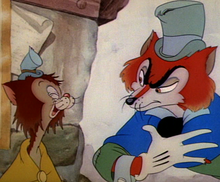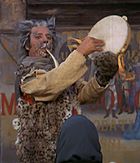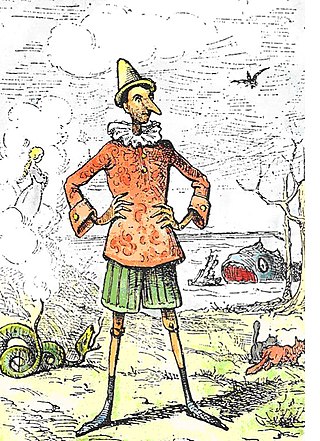
The Adventures of Pinocchio, commonly shortened to Pinocchio, is a children's fantasy novel by Italian author Carlo Collodi. It is about the mischievous adventures of an animated marionette named Pinocchio and his creator and father figure, a poor woodcarver named Geppetto.
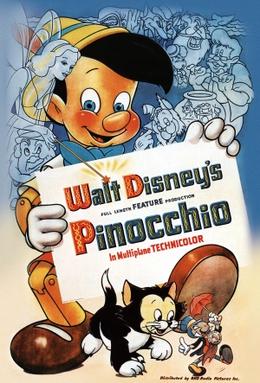
Pinocchio is a 1940 American animated musical fantasy film produced by Walt Disney Productions and released by RKO Radio Pictures. Based on Carlo Collodi's 1883 Italian children's novel The Adventures of Pinocchio, it is the studio's second animated feature film, as well as the third animated film overall produced by an American film studio, after Disney's Snow White and the Seven Dwarfs (1937) and Fleischer Studios' Gulliver's Travels (1939). With the voices of Cliff Edwards, Dickie Jones, Christian Rub, Walter Catlett, Charles Judels, Evelyn Venable, and Frankie Darro, the film follows a wooden puppet, Pinocchio, who is created by an old woodcarver, Geppetto, and brought to life by a blue fairy. Wishing to become a real boy, Pinocchio must prove himself to be "brave, truthful, and unselfish." Along his journey, Pinocchio encounters several characters representing the temptations and consequences of wrongdoing, as a cricket named Jiminy, who takes the role of Pinocchio's conscience, attempts to guide him in matters of right and wrong.

Jiminy Cricket is the Disney version of the "Talking Cricket", a fictional character created by Italian writer Carlo Collodi for his 1883 children's book The Adventures of Pinocchio, which Walt Disney adapted into the animated film Pinocchio in 1940. Originally an unnamed, minor character in Collodi's novel who is killed by Pinocchio before returning as a ghost, he was transformed for the Disney adaptation into a comical and wisecracking partner who accompanies Pinocchio on his adventures, having been appointed by the Blue Fairy to serve as Pinocchio's official conscience. In the film, he sings "When You Wish Upon a Star", the Walt Disney Company's signature song, and "Give a Little Whistle".
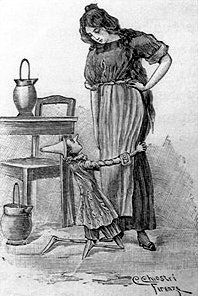
The Fairy with Turquoise Hair is a fictional character in the 1883 Italian book The Adventures of Pinocchio by Carlo Collodi, repeatedly appearing at critical moments in Pinocchio's wanderings to admonish the little wooden puppet to avoid bad or risky behavior.

The Adventures of Pinocchio is a 1996 fantasy comedy family film, directed by Steve Barron and based on the original 1883 novel of the same name by Carlo Collodi. Barron collaborated with Sherry Mills, Tom Benedek and Barry Berman on the screenplay. It was an American, British, French, Czech, and German venture produced by New Line Cinema, The Kushner-Locke Company, Savoy Pictures, Pangaea Holdings and Twin Continental Films. It stars Martin Landau and Jonathan Taylor Thomas. It was a critical and commercial failure which led the sequel, The New Adventures of Pinocchio, straight to video.

Mangiafuoco is a fictional character who appears in Carlo Collodi's 1883 Italian book The Adventures of Pinocchio, serving as a secondary antagonist turning good.

The Coachman, also known as The Little Man (L'Omino), is a fictional character and a major antagonist from Carlo Collodi's 1883 book The Adventures of Pinocchio, in which he appears in chapters XXXI and XXXIII.

The Terrible Dogfish is a dogfish-like sea monster, which appears in Carlo Collodi's 1883 book The Adventures of Pinocchio as the final antagonist. It is described as being larger than a five-story building, a kilometer long and sporting three rows of teeth in a mouth that can easily accommodate a train. So fearsome is its reputation, that in Chapter XXXIV, it is revealed that the Dogfish is nicknamed "The Attila of fish and fishermen".

Pinocchio is a 2002 Italian fantasy comedy-drama film co-written and directed by Roberto Benigni, who also stars. It is based on the 1883 novel The Adventures of Pinocchio by Carlo Collodi, with Benigni portraying Pinocchio. Filming took place in Italy and Kalkara, Malta. It was dedicated to costume and production designer Danilo Donati, who died on 1 December 2001.

The Land of Toys is a fictional location in the Italian novel The Adventures of Pinocchio (1883) that is disguised as a haven of freedom and anarchy for children, but is eventually discovered to be far more sinister.

Geppetto, also known as Mister Geppetto, is an Italian fictional character in the 1883 novel The Adventures of Pinocchio by Carlo Collodi. Geppetto is an elderly, impoverished woodcarver and the creator of Pinocchio. He wears a yellow wig resembling cornmeal mush, and consequently his neighbors call him "Polendina" to annoy him. The name Geppetto is a Tuscan diminutive of the name Giuseppe.

Pinocchio is a fictional character and the protagonist of the children's novel The Adventures of Pinocchio (1883) by Italian writer Carlo Collodi of Florence, Tuscany. Pinocchio was carved by a woodcarver named Geppetto in a Tuscan village. He is created as a wooden puppet, but he dreams of becoming a real boy. He is known for his long nose, which grows when he lies.

The Adventures of Pinocchio is a 1972 Italian animated fantasy film produced by Cartoons Cinematografica Italiana. An adaptation of Carlo Collodi's 1883 book The Adventures of Pinocchio, it is written, produced, directed and edited by Giuliano Cenci. The English dub was released in the United States by G.G. Communications in 1978.

The Talking Cricket is a fictional character that appears in the 1883 Italian book The Adventures of Pinocchio by Carlo Collodi.

Candlewick or Lampwick is a fictional character who appears in Carlo Collodi's 1883 book The Adventures of Pinocchio.

Pinocchio is a 2012 Italian animated film directed by Enzo D'Alò. It is based on the 1883 novel The Adventures of Pinocchio by Carlo Collodi. The film had a budget of about €8 million. It was screened out of competition at the 70th Venice International Film Festival.

The Adventures of Pinocchio is a 1972 Italian five-part miniseries directed by Luigi Comencini, which originally aired weekly on Rai 1 between April 8 and May 6, 1972. Based on Carlo Collodi's 1883 novel with the same name, the miniseries received a large critical success, and had an average of twenty-one and a half million viewers during its first airing. All the episodes together make up 280 minutes of runtime.

Pinocchio is a 2019 fantasy film, co-written, directed, and co-produced by Matteo Garrone, based on the 1883 book The Adventures of Pinocchio by Italian author Carlo Collodi. The film stars child actor Federico Ielapi as the title character, Roberto Benigni as Geppetto, Gigi Proietti as Mangiafuoco, Rocco Papaleo and Massimo Ceccherini as the Cat and the Fox, and Marine Vacth as the adult Fairy with Turquoise Hair. This was the final film featuring Proietti to be released before his death in November 2020.
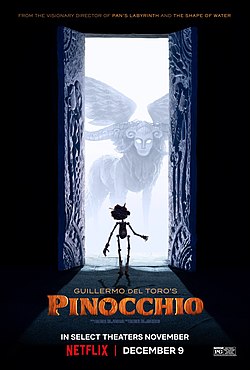
Guillermo del Toro's Pinocchio is a 2022 stop-motion animated musical dark fantasy film directed by Guillermo del Toro and Mark Gustafson, with a screenplay by del Toro and Patrick McHale. Matthew Robbins and del Toro's modified Pinocchio story, drawing from the 1883 Italian novel The Adventures of Pinocchio by Carlo Collodi, was strongly influenced by Gris Grimly's illustrations for a 2002 edition of the book. The film reimagines the adventures of Pinocchio, a wooden puppet who comes to life as the son of his carver Geppetto. Set in Fascist Italy during the interwar period, the film stars the voice of Gregory Mann as Pinocchio and David Bradley as Geppetto, alongside Ewan McGregor, Burn Gorman, Ron Perlman, John Turturro, Finn Wolfhard, Cate Blanchett, Tim Blake Nelson, Christoph Waltz, and Tilda Swinton. Pinocchio was the final film credited to Gustafson before his death in 2024.

Catchfools is a fictional location in the Italian novel The Adventures of Pinocchio (1883).



